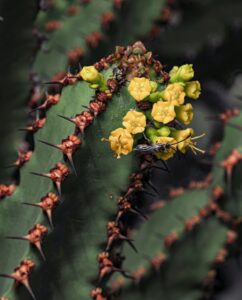Can Fishbone Cactus Live in the Water? Growing a Fishbone Cactus

Cryptocereus anthonyanus by its scientific name and commonly known as fishbone cactus is a member of the night-blooming cactus family. Fishbone cactuses are beautiful succulents that are easily recognizable after their stylish look. Its long, saw-edged arching stems, coated with leaves are making a remarkable appearance.
In its natural habitat, this type of succulent can be found in groups hanging by trees, making this cactus an epiphyte plant. “Epiphytes” is a widely used term that differentiates plants with or without woody growth from trees or other woody plantlets. In other words, plants that are epiphytes can grow on “hosts” which most of the time are trees. They secure their roots into the tree, more specifically, their crannies of branches and/or nooks. The fishbone cactus plantlet originally comes from Mexico; therefore, its favorite habitat is moist and humid with tropical rainforests.
This natural succulent is considered to be a perfect match for beginners, people are looking to start their journey with a plant that is easy to care for. With the correct lighting and some pepper watering, this plantlet will live long and thrive without much effort coming from the owner.
This article will debate the possibility of growing and maintaining a fishbone cactus in a container of just water. Therefore, without any further ado, can fishbone live in water?
So, can fishbone cactus live in water?
To cut to the chase, we shall answer the question early in the article, yes and no. For a better understanding of why both answers are available, we shall discuss them.
As an adult plant, the fishbone cactus cannot live in a body of water. This succulent can only live in trees since they are epiphytes or in pots. However, when it comes to propagation, this gorgeous succulent can live and grow in water for a short period of time.
All you have to do is cut one of the stems off with a clean pair of scissors, the cut has to be made very close to its base. Leave to steam to rest for a few days so the cut can dry out and form a callus, after which you can put in a container of room-temperature water, it is not necessary to fill the container all the way up, it is sufficient to just cover the base where the cut was made. The next step would be to place it in indirect sunlight since that is the preferred sunlight type by the fishbone cactus.
Once these steps are completed the stem will grow roots, when they reach a few inches, the fishbone cactus can be potted in a pot with the appropriate soil mix. Given the fact that this succulent is an epiphyte plantlet, the fishbone cactus should be planted in a well-drained and well-aerated soil mix. A mix made out of perlite and orchid bark will do the plantlet well. Without a soil mix that drains properly and offers ventilation, the roots of the plantlet will rot, ultimately killing the succulent.
Therefore, the fishbone cactus cannot live in water, but it can grow in it when propagated.





